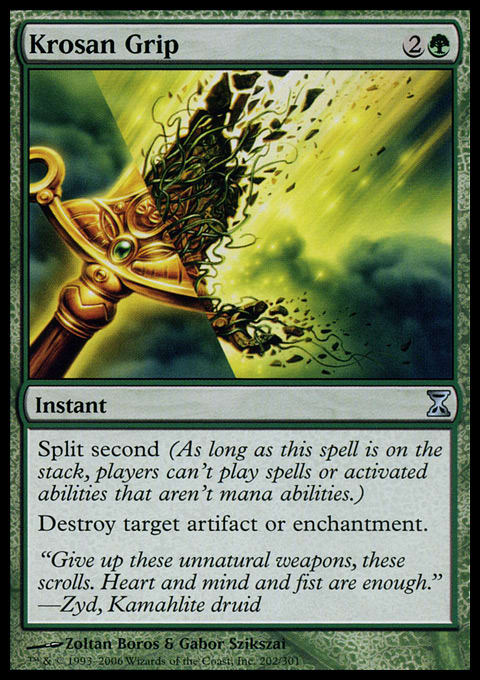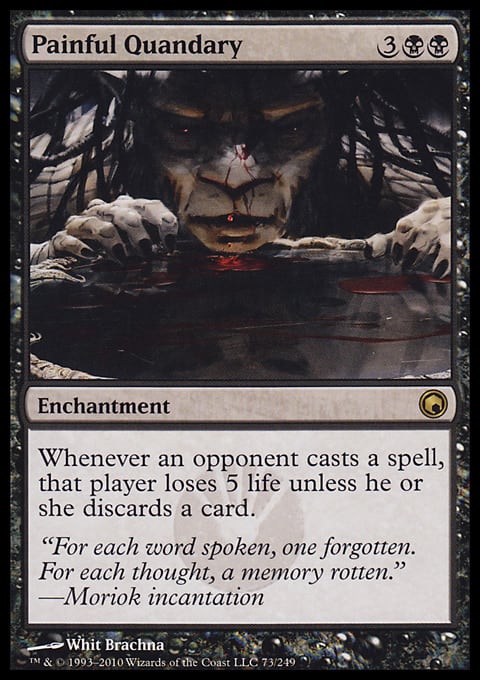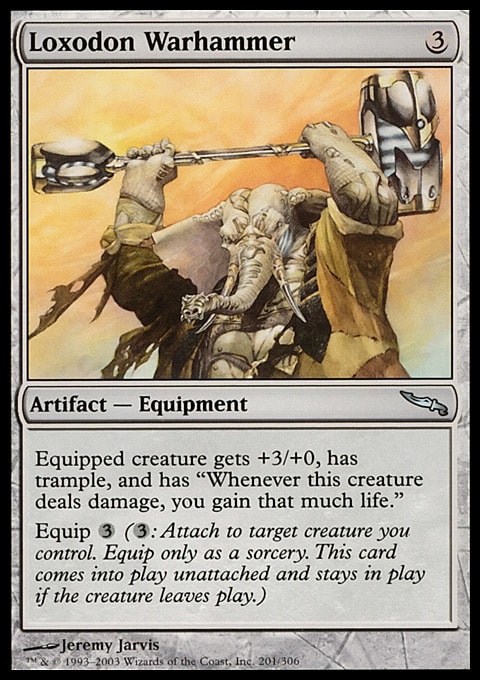. . . or “Attack Rings of Brighthearth for 2”
A couple of months ago, I was the first one to play a creature in a four-player game. Brian/Bosh matched my second-turn Yavimaya Elder with a second-turn Rings of Brighthearth in a deck designed to maximize synergy with it, so I started swinging at him with everything I had. My reasoning was that the Rings was a threatening card, and it meant that Brian’s deck was the furthest along in its strategy, so he should be my highest priority target. With a handful of gas, it seemed like the right thing to do at the time.
What I realized as the game unfolded was that I might have been approaching the threat in the wrong way. That made me start thinking about threat assessment in a couple of different ways, which eventually led to this article. I have two vaguely coherent ideas I want to share with you today. The first is a tentative challenge to the conventional wisdom, and the second is a completely new way of distinguishing between qualitatively different threats.
Matching Threats and Answers
Would you have made the same decision I did in attacking the player with the most powerful and seemingly threatening permanent? I expect most of you would have—trying to prune the life total of the most threatening player at the table makes it easier to deal with that player later. Additionally, it might make your opponent less likely to retaliate if you have a clear, non-personal reason for attacking him. “Fair enough,” he may say. “I’d probably attack the guy with the Rings, too!”
But in this case, attacking for 2 does nothing to directly address the threat that Rings of Brighthearth presents. The only 2-power critters that will really do anything in this situation are Manic Vandal, Uktabi Orangutan, and the like. In other words, is it really worth responding to a threat in a way that doesn’t actually solve the problem? As long as your deck contains ways to directly eliminate a single-card threat like Rings, maybe it’s better to wait for those answers rather than responding on an irrelevant axis.
I’m not saying that it is always correct to ignore a single-card threat that you can’t answer right away, but I think it is worth asking if it is sometimes correct. After all, I was using the same system of deciding whom to attack eighteen years ago when I first started playing; maybe it’s time to evolve a new paradigm.
Here’s what I would suggest the next time you have an early beater and an opponent has played a permanent that is generically threatening in the long term but not immediately scary: Consider leaving him alone and smacking someone else . . . or at least don’t single him out for a beating. There are two potential advantages—first, you are more likely to pressure other players to deal with it, and second, you are less likely to find yourself in a duel with that player. In the event, someone else hits Rings with a Krosan Grip, but Bosh came after me because of the damage I’d done to him!
That kind of free riding deserves an article all to itself, but the basis of it is pretty simple: The more pressure you put on a player, the less threatening he will appear to everyone else, and so the less likely others will be to spend their removal on that Rings of Brighthearth (or whatever the threatening card may be).
How Many Different Types of Threat Are there?
At the same time, I started thinking about breaking down all of the different types of threat we run into—the explosive start, the best deck-builder, the player with the grudge, the deck with one card that just wrecks you—but I quickly realized that a list of twenty different ways your opponents can scare the crap out of you isn’t much help. Then, I started thinking about how to organize those different types of threats and realized that most of them can be organized according to two main factors: the distinction between immediate and long-range threats and the distinction between individual and group threats.
Here are some examples of how this division works out:1
| Short-Term Threats | Long-Term Threats | |
| Threats to You | Aggro deck targeting you specifically (e.g. a poison deck, where you are the only one with poison counters, or a weenie swarm when you don’t have any blockers)
Cards/strategies that only really hurt you (e.g. a turn-two Stigma Lasher from an otherwise weak deck against your life-gain deck). |
Cards and strategies you are specifically vulnerable to (e.g. Ihsan's Shade is the commander against your mono-white deck)
Players who regard you as their primary threat (combo decks worried about your permission, graveyard decks worried about your Tormod's Crypt, BPS, etc.) |
| Threats to the Whole Table | Lock decks (turn-two, Birds of Paradise, Winter Orb, go)
Combo decks |
Punisher decks
Scalable commanders (Drana, Molimo, Maga, etc.)
The strongest deck and/or the best player
The Quiet Guy
Captain Card Advantage |
In other words, there are some threats that seem urgent but are temporary, and there are other threats that kind of sneak up on you. There’s the aggro deck that can put you to single-digit life on turn four or five, and there’s the Rock deck that will bury you in card advantage in the mid- to late-game. Similarly, there are some things that are threatening to the whole table and other threats that seem more dangerous to one or two players. You have to react to all of these threats, spend removal against all of these threats, and attack all of these threats, but without understanding the differences between them, you can’t decide between them all, and you will inevitably make mistakes.
Sometimes, I’ve been paralyzed by indecision because everyone was a threat and I didn’t have enough answers; other times, I’ve attacked a different person each turn, wasting my time trying to answer every conceivable threat by myself and running out of gas. I never won those games.
As you know, if you want to survive the early game you have to withstand the early threats, but to win the long game, you have to have enough resources left over to deal with the last few opponents. Most multiplayer veterans have also figured out that the best way to deal with a threat is to have someone else deal with it, while the worst way to deal with a threat is to leave it, hoping that someone else will eliminate it—until it overwhelms you.
Every multiplayer game is an attempt to achieve these two different balances simultaneously; many multiplayer losses result from a failure in one area or another. That’s why I think this Multiplayer Threat Assessment Matrix . . . dammit, I mean, this Handy-Dandy Table . . . is going to help you to win a lot of games.
When you look at the first axis, the short- to long-term axis, you need to think about when a threat is going to getcha.2 Broadly speaking, an aggro deck is going to beat you now or it isn’t going to beat you at all, while a Rock deck is just going to two-for-one you now, but eventually, it’ll have a full hand and a wall of fatties while you're living off the top of your deck. Which threat is worse? Impossible to say; they’re just different types of threats, and you need a different strategy to deal with each.
The second axis, individual or group threats, is a little more subjective. A player who is coming after you like you’re the six-fingered man is only a threat to you, and you probably can't look to the rest of the table for help; a player who’s dropping Painful Quandary, Pestilence, and Cabal Conditioning isn’t looking to make any friends, and you can expect full support from the rest of the table if you go after him. In the first case, the opponent is coming for you and you alone, and you need to expend your own resources to defend yourself. The same is true against a deck against which you can’t block creatures—or the Meekstones lock out your fatties or whatever. When a free-for-all becomes a duel, you may not have a lot of options in terms of how to survive. You can either deal with those threats on your own, make yourself valuable enough to someone else that he’ll help you to deal with them, or you can die.
The trick is to realize when other people are threatened by the same stuff you are and to hold back just enough so that they deal with it for you. You don’t necessarily want those other people to be overwhelmed by the threat, but you want your opponents to whittle each other down for you. It’s like Clint Eastwood in A Fistful of Dollars: he didn’t have enough bullets to kill all of the Baxters’ men and all of Rojo’s men, so he got them to kill each other. Then in the last scene, he had plenty of ammo to finish everyone off.
As an example, yesterday I was in a four-player game with a potentially nasty Damia, Sage of Stone (poison and proliferate) deck and a very strong Rafiq Voltron deck. When Rafiq dropped Loxodon Warhammer, I started to become a bit nervous because my Urabrask deck was well on the way to dropping everyone to single digits, and the last thing I wanted to face was double-striking life-gain. However, I soon realized that Rafiq was on the life-gain plan, intending to ride the Warhammer to victory, so who did he see as the biggest threat? Obviously, the poison deck was the only deck likely to kill him when he was gaining 14 life per turn, so I said, “Good luck!” to Damia and focused on the other guy. When Damia died, I turned my attention back to Rafiq, but not before I’d given Damia every possible chance to screw him over.3
Theory in Practice
Here are the general strategies that I would suggest employing in regards to each type of threat.
| Short-Term Threats | Long-Term Threats | |
| Threats to You | Withstand | Relentless Assault |
| Threats to the Whole Table | Call to Arms | Attrition/Coalition Victory |
If someone is an immediate threat to you and only you, of course you have to do anything to Withstand that. Use your resources as sparingly as possible, though, and settle for deterring them rather than going all Keyser Soeze on them; remember that you only need to survive the short-term threat, not necessarily eliminate the player. Once the immediate threat has subsided, focus on the long game.
For a deck that threatens the whole table right away, a Call to Arms is the best strategy. Do everything you can to mobilize the rest of the table against the threat so that you don’t have to do all the heavy lifting yourself. Once again, it’s all about resource management; if you survive, your former allies will be your future threats, so you want their hands to be as badly depleted as yours.
If someone’s long-term plan is uniquely antithetical to yours, a Relentless Assault may be necessary. For example, a guy I used to play with had an Oros deck that brutalized any creature-based strategies. Between cards like Meekstone, Humility, Torpor Orb and a couple of sweepers, there just wasn’t much that a creature deck could do against him. As a result, whenever I played an aggro deck like Kresh or Molimo against him, I always hit him a lot harder than he thought he deserved. He would often complain that I wasn’t being fair to him, but I knew that if he got a chance to set up his board, it would be too late for me to respond.4
Finally, for the deck that is most threatening to the whole table over the long term—the deck that most legitimately deserves to be called the strongest deck—I recommend an Attrition by Coalition strategy. You have to try to wear these decks down over time, but if they’re really that strong, you probably can’t afford to do it alone. This brings me back to the point I was trying to make about Rings of Brighthearth: The other players at the table can be your most valuable resources in dealing with these kinds of long-term threats, and you have to manage them, too. Try to foster a sense of communal threat rather than giving the impression that you’re going to handle the threat solo.
The bottom line is that you usually can't do everything on your own, which means that focusing on the threats that hurt you the most while getting others to deal with threats to the entire group is an essential part of conserving your strength and winning the long game. If you do it wrong, you’ll find yourself picking fights with everyone and getting spanked (and not in a good way); do it right, and you’ll be the last man standing.5
1 Andy from CommanderCast introduced the phrase “Threat Assessment Matrix” and then immediately discarded it because it sounds too pretentious. I’ll defer to Andy and avoid using the phrase, although that’s basically what it is.
2 A quick note on the table: I know that the distinctions between short and long games and between individual and group threats are not binary as I have presented them here. Obviously, there’s a difference between an aggro deck with a two-turn clock and one with a five-turn clock. Some combo decks don’t go off until the late game, and some decks aren’t really combo at all, but they do contain one overwhelming combo just in case the game goes long.
If, for example, you are playing against a deck that destroys all of your nonland permanents with a recurring Woodfall Primus on turn eight, that’s more of a mid- to late-game threat that a second-turn Erayo lock. In the same way, a deck that presents a unique threat to two out of six players is going to be easier for those decks to deal with together than if only one of those decks was threatened by it.
I’m trying to represent the archetypal threats here, so I realize the model won’t apply perfectly to every conceivable situation. The alternative is to present it like a graph with an x-axis and a y-axis, but it seems pointless to pretend that I can distinguish between a deck that scores three for urgency and a deck that scores four for urgency. For that reason, the binary distinction seems like the best way to present this idea.
3 As it happens, Rafiq was able to slip on a Mask of Avacyn to go with the Hammer (and a Sword of Vengeance!), so I wasn’t able to put him away, but I believe the strategy was sound; all I needed was one piece of artifact removal, and I would have taken him to the cleaners.
4 This, by the way, is the downside of having most of your removal in the form of 187 creatures. There are few things worse than being locked under a Humility with an Acidic Slime, a Brutalizer Exarch, and a Woodfall Primus in your hand.
5 Unless you’re a woman, of course.


























